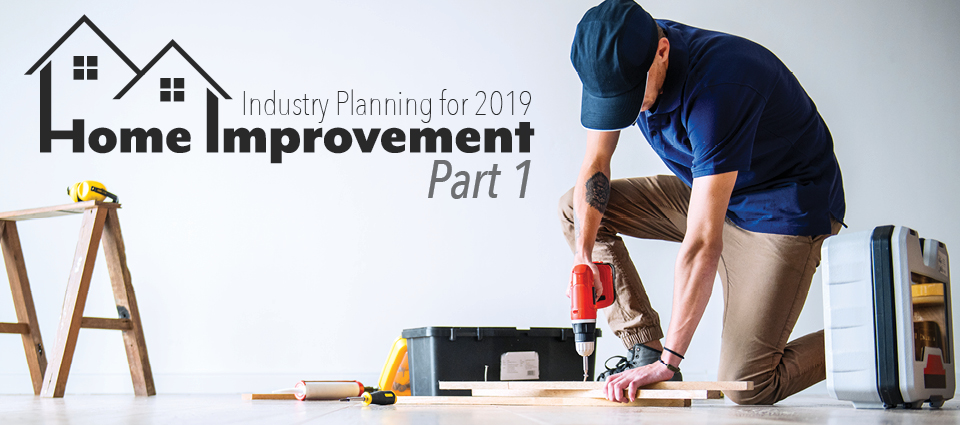Home Improvement Industry Planning for 2019 Part 1: The Big Picture
December 03, 2018Will 2019 be the year of tackling home improvement projects?
Taking a look at national trends in the home owner and construction landscapes and examining buyer and purchase behaviors gives a pretty clear idea what to expect for the home improvement industry for 2019.
Because there’s so many factors to consider, we are answering this question in a two-part series. This part examines 6 key drivers in the big picture. We will address household growth, home ownership rates, home value, renovation, construction and consumer confidence. We will dissect buyer purchase behaviors in the second installment of this series.
Unless otherwise sourced, all data is from the Planning for 2019 in Home Improvement webinar presented by Askuity.
Driver #1: Household Growth
Historically, household growth was 1.2 million household units per year. It’s currently holding steady at about 800,000 households per year.
Millennials and Gen Z will account for 60% of the U.S. population by 2022, These 2 generational demographics will be the key drivers of demand to set up their own households.
Driver #2: Home Ownership Rates
The home ownership rate is the percentage of homes occupied by the homeowner (or the percentage of existing homes that are not sitting vacant). From 1965 to 2018, the average home ownership rate was 65.24%. Home ownership rates have increased by less than 1% from 2015 to 2018, according to the most recent data available from Trading Economics.
• July 2018: 64.3%
• January 2018: 64.2%
• July 2017: 63.7%
• January 2017: 63.7%
• July 2016: 62.9%
• January 2016: 63.5%
• July 2015: 63.7%
Driver #3: Median Home Value
In general, there are fewer homes for sale and the ones that are for sale are more expensive. Home sales are leveling off. Mobility rates—how frequently people change their residences—have been impacted as a result.
Traditionally, mobility rates have been considered a key driver for remodeling activity. When people sell their homes, they remodel to entice buyers and increase buyers. Homeowners renovate and remodel after they purchase their homes.
There was concern that if mobility slows down, the need for remodeling would decrease. That concern doesn’t seem to match what’s happening. Homeowners are choosing to stay in their homes and thus tackling the remodeling projects that they want to do. Home improvement industry expert Grant Farnsworth noted that these are national trends and vary by regional market in the Planning for 2019 in Home Improvement webinar.
The midway point of all houses/units sold at market price or higher:
• in 2018, 337.2 new homes & 250.4 existing homes
• in 2016, 313.2 new homes & 235.5 existing homes
• in 2012, 245.2 new homes & 177.2 existing homes
• in 2008, 232.1 new homes & 196.6 existing homes
The sales of new and existing single family homes:
• 2018: 5,340 existing homes & 627 new homes
• 2017: 5,536 existing homes & 616 new homes
• 2016: 5,441 existing homes & 559 new homes
• 2015: 5,254 existing homes & 502 new homes
• 2014: 4,916 existing homes & 437 new homes
• 2008: 4,350 existing homes & 485 new homes
Driver #4: Renovation Outlook
Most homeowners on Houzz, site and online community for home design planned to spend a median amount of $10,000 for renovations in 2018, according to the Overview of US Renovation in 2017 and 2018 report from Houzz.
51% of homeowners on Houzz plan to begin or continue renovations in 2018. There are 40 million Houzz users, 90% of whom are homeowners. In 2017, 58% of homeowners renovated their homes and spent a median $15,000.
Kitchen and bathroom were the top two homeowner projects. We provided an overview of home renovation projects in our The Reno Landscape in 2018 blog.
Driver #5: Construction Outlook
Since late 2013, most units under construction are multi-family but the trend is moving from multi-family to single-family housing units, National Association of Home Builders Chief Economist Robert Dietz said in the NAHB’s Housing & Economic Forecast.
Construction in single-family units is expected to increase in the next 3 years.
• 2018: 925,000
• 2019 forecast: 991,000
7% growth from 2018-2019
• 2020 forecast: 1,039,000,
6% growth from 2019-202
On the other hand, the multi-family construction is not expected to grow overall. 2015 was the peak year for multi-family started with about 394,000 units under construction. These units are mostly in the rental supply pipeline, to put things in perspective.
However, townhouse construction projects are a bright spot. Townhouse construction has about 12% of the total new/existing housing market construction market. This is expected to continue increasing and should account for 15% of this construction market. Millennials are driving the demand for townhouses.
The custom-building market remains flat. It holds about 20% of the total new/existing housing construction market and this share is expected to continue falling slowly.
Total construction in multi-family units are forecast to be:
• 2018: 390,000
• 2019 forecast: 354,000
-9% growth from 2018-2019
• 2020 forecast: 340,000
-4% growth from 2019-2020
Driver #6: Consumer Confidence
Consumer confidence measures how consumers feel about the current future economic conditions. It is used as one way to measure the state of the overall economy.
Consumer confidence is high. Anything above 90 is considered strong. Confidence levels below 80 are causes for concern. Here’s a look at consumer confidence levels:
• August 2018,: 111
• February 2018: 312
• February 2017: 126
• January 2015: 121
• January 2013: 94
• January 2011: 61
• January 2010: 57
• September 2008: 38
• October 2007: 95
Image was "Designed by rawpixel.com / Freepik"

